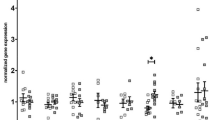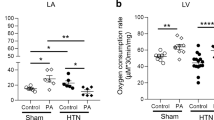Abstract
The effect of long-lasting in vivo restriction of nitric oxide (NO) bioavailability on cardiac and renal P-type ATPases critical for intracellular ion homeostasis is controversial. Previous work has shown in eNOS knockout (eNOS−/−) mice hearts that Na+/K+- and Ca2+-ATPase activities were depressed but the underlying mechanisms are still unclear. The goal of this study was to characterize potential alterations responsible for impaired enzyme activity in eNOS−/− mice. Na+/K+-ATPase activity from crude preparations of adult male eNOS−/− mice hearts and kidneys was reduced compared with wild-type animals (32 %, p < 0.05 and 16 %, p < 0.0001, respectively). Immunoblot analysis showed that although the expression of the predominant (or exclusive, for the kidney) Na+/K+-ATPase α1 isoform was not significantly changed, there was an important downregulation of the less abundant α2 isoform in the heart (57 %, p < 0.0001). In addition, although cardiac Ca2+-ATPase activity was unaltered, the expression of sarco/endoplasmic reticulum Ca2+-ATPase 2 protein in eNOS−/− mice was very high (290 % compared with wild-type animals, p < 0.0001) without any significant change in phospholamban expression. Consistent with these findings, the content of cardiac and renal free sulfhydryl groups, essential for the catalytic function of such ATPases, was decreased (23 %, p < 0.01 and 35 %, p < 0.05, respectively). Altogether, the present results suggest that the absence of eNOS promotes a compartmentalized altered redox balance that affects the activity and expression of ion transport ATPases.





Similar content being viewed by others
Abbreviations
- DTNB:
-
5,50-dithiobis-(2-nitrobenzoic acid)
- eNOS:
-
Endothelial nitric oxide synthase
- eNOS−/− :
-
eNOS knockout
- l-NAME:
-
N G-nitro-l-arginine methyl ester
- NO:
-
Nitric oxide
- PMCA:
-
Plasma membrane Ca2+-ATPase
- PMSF:
-
Phenylmethylsulfonyl fluoride
- ROS:
-
Reactive oxygen species
- SERCA:
-
Sarco/endoplasmic reticulum Ca2+-ATPase
- WT:
-
Wild type
References
Ait-Mamar B, Cailleret M, Rucker-Martin C et al (2005) The cytosolic phospholipase A2 pathway, a safeguard of β2-adrenergic cardiac effects in rat. J Biol Chem 280:18881–18890
Bambrick LL, Howlett EE, Feng ZP et al (1988) Radioligand binding to muscle homogenates to quantify receptor and ion channel numbers. J Pharmacol Methods 20:313–321
Barreto F, Rezende DC, Scaramello CB et al (2010) Lack of evidence for regulation of cardiac P-type ATPases and MAP kinases in transgenic mice with cardiac-specific overexpression of constitutively active α1B-adrenoceptors. Braz J Med Biol Res 43:500–505
Barouch LA, Harrison RW, Skaf MW et al (2002) Nitric oxide regulates the heart by spatial confinement of nitric oxide synthase isoforms. Nature 416:337–339
Bartunek J, Weinberg EO, Tajima M et al (2000) Chronic N(G)-nitro-l-arginine methyl ester-induced hypertension: novel molecular adaptation to systolic load in absence of hypertrophy. Circulation 101:423–429
Benz D, Cadet P, Mantione K et al (2002) Tonal nitric oxide and health: a free radical and a scavenger of free radicals. Med Sci Monit 1:RA1–RA4
Champion HC, Georgakopoulos D, Takimoto E et al (2004) Modulation of in vivo cardiac function by myocyte-specific nitric oxide synthase-3. Circ Res 94:657–663
Chen Y, Traverse JH, Du R et al (2002) Nitric oxide modulates myocardial oxygen consumption in the failing heart. Circulation 106:273–279
Feron O, Belhassen L, Kobzik L et al (1996) Endothelial nitric oxide synthase targeting to caveolae. Specific interactions with caveolin isoforms in cardiac myocytes and endothelial cells. J Biol Chem 271:22810–22814
Flaherty MP, Brown M, Grupp IL et al (2007) eNOS deficient mice develop progressive cardiac hypertrophy with altered cytokine and calcium handling protein expression. Cardiovasc Toxicol 7:165–177
Gkaliagkousi E, Ferro A (2011) Nitric oxide signalling in the regulation of cardiovascular and platelet function. Front Biosci 16:1873–1897
Graebe M, Brond L, Christensen S et al (2004) Chronic nitric oxide synthase inhibition exacerbates renal dysfunction in cirrhotic rats. Am J Physiol Ren Physiol 286:F288–F297
Herrera VLM, Chobanian AV, Ruiz-Opazo N (1988) Isoform-specific modulation of Na+, K+-ATPase α-subunit gene expression in hypertension. Science 241:221–223
Hirst FX, Robson T (2011) Nitric oxide physiology and pathology. Methods Mol Biol 704:1–13
Huang WH, Wang Y, Askari A et al (1994) Different sensitivities of the Na+/K+-ATPase isoforms to oxidants. Biochim Biophys Acta 1190:108–114
Hummel SG, Fischer AJ, Martin SM et al (2006) Nitric oxide as a cellular antioxidant: a little goes a long way. Free Radic Biol Med 40:501–506
Javorková V, Vlkovicova J, Kunes J et al (2007) Effect of maturation on renal Na+/K+-ATPase and its susceptibility to nitric oxide-deficient hypertension in rats. Clin Exp Pharmacol Physiol 34:617–623
Jo H, Otani H, Jo F et al (2011) Inhibition of nitric oxide synthase uncoupling by sepiapterin improves left ventricular function in streptozotocin-induced diabetic mice. Clin Exp Pharmacol Physiol 38:485–493
Khan SA, Skaf MW, Harrison RW et al (2003) Nitric oxide regulation of myocardial contractility and calcium cycling: independent impact of neuronal and endothelial nitric oxide synthases. Circ Res 92:1322–1329
Kim JS, Choi KC, Jeong MH et al (2006) Increased expression of sodium transporters in rats chronically inhibited of nitric oxide synthesis. J Korean Med Sci 21:1–4
Kopkan L, Hess A, Husková Z et al (2010) High-salt intake enhances superoxide activity in eNOS knockout mice leading to the development of salt sensitivity. Am J Physiol Ren Physiol 299:F656–F663
Li W, Mital S, Ojaimi C et al (2004) Premature death and age-related cardiac dysfunction in male eNOS-knockout mice. J Mol Cell Cardiol 37:671–680
Liu L, Mohammadi K, Aynafshar B et al (2003) Role of caveolae in signal-transducing function of cardiac Na+/K+-ATPase. Am J Physiol Cell Physiol 284:C1550–C1560
Nediani C, Raimondi L, Borchi E et al (2011) Nitric oxide/reactive oxygen species generation and nitroso/redox imbalance in heart failure: from molecular mechanisms to therapeutic implications. Antioxid Redox Signal 14:289–331
Noël F, Godfraind T (1984) Heterogeneity of ouabain specific binding sites and Na+, K+-ATPase inhibition in microssomes from rat heart. Biochem Pharmacol 33:47–53
Ostadal P, Elmoselhi AB, Zdobnicka I et al (2004) Role of oxidative stress in ischemia-reperfusion-induced changes in Na+, K+-ATPase isoform expression in rat heart. Antioxid Redox Signal 6:914–923
Pôças ESC, Touza NA, Pimenta PH et al (2008) Insights into the mechanism of Na+, K+-ATPase inhibition by 2-methoxy-3,8,9-trihydroxy coumestan. Bioorg Med Chem 16:8801–8805
Quintas LEM, Cunha VMN, Scaramello CB et al (2005) Adaptive expression pattern of different proteins involved in cellular calcium homeostasis in denervated rat vas deferens. Eur J Pharmacol 525:54–59
Quintas LEM, Noël F, Wibo M (2007) Na+/K+-ATPase α isoforms expression in stroke-prone spontaneously hypertensive rat heart ventricles: effect of salt loading and lacidipine treatment. Eur J Pharmacol 565:151–157
Reifenberger MS, Arnett KL, Gatto C et al (2008) The reactive nitrogen species peroxynitrite is a potent inhibitor of renal Na–K-ATPase activity. Am J Physiol Ren Physiol 295:F1191–F1198
Schaffazick N, Amaral LS, Fonseca TF et al (2010) Effect of heparin treatment on the expression and activity of different ion-motive P-type ATPase isoforms from mouse extensor digitorum longus muscle during degeneration and regeneration after Bothrops jararacussu venom injection. Toxicon 55:52–60
Schoot BM, De Pont JJHHM, Bonting SL (1978) Studies on (Na+/K+)-activated ATPase. XLII. Evidence for two classes of essential sulfhydryl groups. Biochim Biophys Acta 522:602–613
Scrogin KE, Hatton DC, Chi Y (1998) Chronic nitric oxide inhibition with l-NAME: effects on autonomic control of the cardiovascular system. Am J Physiol 274:R367–R374
Shesely EG, Maeda N, Kim HS et al (1996) Elevated blood pressures in mice lacking endothelial nitric oxide synthase. Proc Natl Acad Sci 93:13176–13181
Vlkovicová J, Javorková V, Mézesová L et al (2008) Regulatory role of nitric oxide on the cardiac Na, K-ATPase in hypertension. Physiol Res 57(Suppl 2):S15–S22
Vrbjar N, Bernátová I, Pechánová O (1999) Changes of sodium and ATP affinities of the cardiac (Na, K)-ATPase during and after nitric oxide deficient hypertension. Mol Cell Biochem 202:141–147
Vrbjar N, Bernátová I, Pechánová O (1999) Functional alterations of cardiac (Na, K)-ATPase in l-NAME induced hypertension. Gen Physiol Biophys 18(Suppl 1):10–12
Vrbjar N, Javorková V, Pechánová O (2002) Changes of sodium and ATP affinities of the renal Na, K-ATPase during and after nitric oxide-deficient hypertension. Physiol Res 51:475–481
Vrbjar N, Pechánová O (2002) Sodium and ATP affinities of the cardiac (Na, K)-ATPase in relation to nitric oxide synthesis in spontaneously hypertensive rats. Life Sci 71:1751–1761
Xie ZJ, Wang JH, Askari A et al (1990) Studies on the specificity of the effects of oxygen metabolites on cardiac sodium pump. J Mol Cell Cardiol 22:911–920
Xu KY, Kuppusamy SP, Wang JQ et al (2003) Nitric oxide protects cardiac sarcolemmal membrane enzyme function and ion active transport against ischemia-induced inactivation. J Biol Chem 278:41798–41803
Xu KY, Zweier JL, Becker LC (1997) Oxygen-free radicals directly attack the ATP binding site of the cardiac Na+, K+-ATPase. Ann N Y Acad Sci 834:680–683
Xu KY, Zweier JL, Becker LC (1997) Hydroxyl radical inhibits sarcoplasmic reticulum Ca2+-ATPase function by direct attack on the ATP binding site. Circ Res 80:76–81
Zhou L, Burnett AL, Huang PL et al (2002) Lack of nitric oxide synthase depresses ion transporting enzyme function in cardiac muscle. Biochem Biophys Res Commun 294:1030–1035
Acknowledgments
Research supported by FAPERJ, FAPESP, and CNPq-PRONEX. A. Caricati-Neto, A. Jurkiewicz, and F. Noël are recipients of CNPq research fellowships.
Author information
Authors and Affiliations
Corresponding author
Rights and permissions
About this article
Cite this article
Rezende, D.C., Pôças, E.S.C., Muzi-Filho, H. et al. Mechanisms associated to impaired activity of cardiac P-type ATPases in endothelial nitric oxide synthase knockout mice. J Physiol Biochem 69, 207–214 (2013). https://doi.org/10.1007/s13105-012-0203-x
Received:
Accepted:
Published:
Issue Date:
DOI: https://doi.org/10.1007/s13105-012-0203-x




